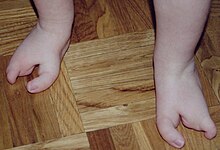| Oligodactyly | |
|---|---|
 | |
| Oligodactyly as a result of ectrodactyly on the feet of a one-year-old child | |
| Specialty | Medical genetics |
Oligodactyly (from Greek ὀλίγος (olígos) 'few' and δάκτυλος (daktylos) 'finger') is the presence of fewer than five digits (fingers or toes) on a hand or foot.
It is quite often incorrectly called hypodactyly; the Greek prefixes hypo- and hyper- are used for continuous scales (e.g. in hypoglycaemia and hyperthermia), as opposed to discrete or countable scales, where oligo- and poly- should be used (e.g. in oligarchy and polygamy). Oligodactyly is therefore the opposite of polydactyly. Very rare, this medical condition usually has a genetic or familial cause.
Oligodactyly is sometimes a sign or symptom of several syndromes including Poland syndrome and Weyer Ulnar Ray Syndrome. It is a type of dysmelia.
Ectrodactyly is an extreme instance of oligodactyly, involving the absence of one or more central digits of the hand or foot and is also known as split hand/split foot malformation (SHFM). The hands and feet of people with ectrodactyly are often described as "claw-like" and may include only the thumb and one finger (usually either the little finger, ring finger, or a syndactyly of the two) with similar abnormalities of the feet.
People with oligodactyly often have full use of the remaining digits and adapt well to their condition. They are not greatly hindered in their daily activities, if at all. Even those with the most extreme forms are known to engage in tasks that require fine control, such as writing and bootmaking as well as working as a cab driver.
The Wadoma people of Zimbabwe have a high frequency of oligodactyly.
References
- NIH website, citing Merriam-Webster's Medical Dictionary. Accessed February 16, 2010.
- ^ Medical terms Dictionary Archived 2014-05-15 at the Wayback Machine. Accessed February 16, 2010
- ^ Conrad, Matthew; Ezaki, Marybeth (2002). "Fewer than 10: Oligodactyly-Diagnoses and patterns of malformation". Journal of the American Society for Surgery of the Hand. 2 (3): 110–120. doi:10.1053/jssh.2002.34791. Retrieved February 16, 2010.
- ^ Meredith Vaughn Jones (Nov 1957). "Oligodactyly". Journal of Bone and Joint Surgery. B (39): 752–754. doi:10.1302/0301-620X.39B4.752. PMID 13491644.
- P D Turnpenny, J C Dean, P Duffty, J A Reid, and P Carter, "Weyers' ulnar ray/oligodactyly syndrome and the association of midline malformations with ulnar ray defects." J Med Genet. 1992 September; 29(9): 659–662. Found at NIH website. Accessed last on February 17, 2010.
- Moerman, P.; Fryns, J.P. (1998). "Ectodermal dysplasia, Rapp–Hodgkin type in a mother and severe ectrodactyly-ectodermal dysplasia-clefting syndrome (EEC) in her child". American Journal of Medical Genetics Part A. 63 (3): 479–81. doi:10.1002/(SICI)1096-8628(19960614)63:3<479::AID-AJMG12>3.0.CO;2-J. PMID 8737656.
- Peterson-Falzone, Sally J.; Hardin-Jones, Mary A.; Karnell, Michael P.; McWilliams, Betty Jane (2001). Cleft Palate Speech. Mosby. ISBN 978-0-8151-3153-3.
- ^ Lewis, Thomas (1908). "The Inheritance of Deformities". British Medical Journal. 2 (2481): 166–173. doi:10.1136/bmj.2.2481.166. S2CID 220153781.
- Farrell HB (1984). "The two-toed Wadoma--familial ectrodactyly in Zimbabwe". S. Afr. Med. J. 65 (13): 531–3. PMID 6710256.
- Ripley's believe it or not (with photo).
External links
| Classification | D |
|---|
| Congenital malformations and deformations of musculoskeletal system / musculoskeletal abnormality | |||||||||||||||||||||||
|---|---|---|---|---|---|---|---|---|---|---|---|---|---|---|---|---|---|---|---|---|---|---|---|
| Appendicular limb / dysmelia |
| ||||||||||||||||||||||
| Axial |
| ||||||||||||||||||||||